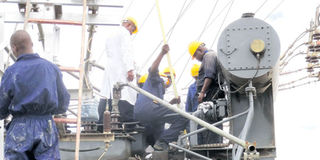Grid upgrade cuts power losses by 56pc

Kenya Power workers upgrade Makande power station, in Mombasa, to improve electricity distribution. PHOTO | FILE
What you need to know:
- Electricity is lost in three levels; during transmission from the generation station to substations; in the course of distribution from the substation to customers; and at some customer premises through the tampering of metres.
- During the current financial year, Kenya Power has budgeted about Sh52 billion for network upgrade across the country. Among the projects lined up is the installation of new substations and power lines.
Electricity losses have reduced by more than 50 per cent after Kenya Power revamped its network.
The latest data from the Kenya National Bureau of Statistics (KNBS) shows that 62.93 million units of electricity were lost in February compared to 145.69 million units in January, a 56.8 per cent decline.
Electricity losses for November and December last year were 95.20 million units and 113.26 million respectively.
“What we are seeing now is the result of the investment in upgrading the network that we carried out last year,” said Kenya Power managing director Ben Chumo by phone.
“We expect to see the losses reducing in the coming months with continued projects to upgrade and expand the network.”
Power losses refer to the difference between the amount of electricity generated and what is sold to consumers.
Electricity is lost in three levels; during transmission from the generation station to substations; in the course of distribution from the substation to customers; and at some customer premises through the tampering of metres.
LOW VOLTAGE LINES
According to industry analysts, the losses occur as a result of a weak electricity distribution network that cannot support a certain level of power generation.
Vandalism of equipment such as transformers and cables also results in losses.
Kenya Power attributed the increase in power losses for two consecutive months from November last year on to accelerated electricity connection to households and small businesses, which rely on low voltage lines that are prone to losses.
“Maintaining low voltage lines is expensive and they tend to increase the losses especially when you have to extend them,” said Mr Chumo.
Power losses are currently at about 17 per cent. Kenya Power targets to cut this to 15 per cent by the end of 2016.
The acceptable level of losses depends on the size of a country’s grid network, with those that have a wide network being prone to big losses.
According to the industry, one per cent loss translates into Sh1 billion losses in revenue for Kenya Power.
The KNBS data shows that total local electricity generation reduced from 775 million units in January to 702 million units in February. Electricity sales, however, increased from 601.25 million units to 611.57 million units during the same period.
During the current financial year, Kenya Power has budgeted about Sh52 billion for network upgrade across the country. Among the projects lined up is the installation of new substations and power lines.
In February, the utility issued tenders for construction of 36 substations across the country at a cost of Sh10.5 billion.
BAGGED TENDERS
Mastermind Tobacco’s engineering company, NGM Limited and advertising company Magnate Ventures are among the firms that bagged the lucrative tender.
The rest of the eight companies that were chosen to build the substations were mostly from India, Saudi Arabia and Iran.
The foreign companies will set up 20 substations at a cost of Sh5.8 billion.
In total, the utility is expected to build 98 new substations by the end of June, next year.
Kenya Power posted a 38.5 per cent jump in its after-tax profit for the half year period to December 2014, mainly attributed to increased electricity sales and a jump in electricity tariff by the Energy Regulatory Commission during the period.
Revenue from electricity sales increased from Sh26.9 billion in a similar period in 2013 to Sh37.6 billion in the period under review.
The firm announced that during the half year period, it had spent Sh10 billion to upgrade its electricity distribution network through replacement of old power distribution lines, transformers and refurbishment of substations and installation of new ones.





